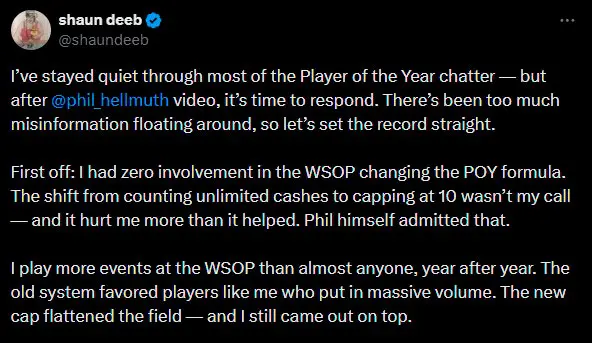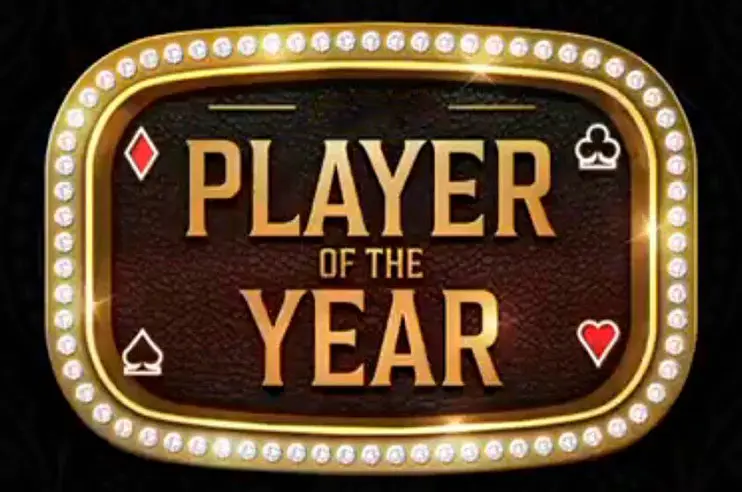- Home
- Latest poker news
- Phil Hellmuth vs. Shaun Deeb: WSOP Player of the Year controversy
Phil Hellmuth vs. Shaun Deeb: WSOP Player of the Year controversy
The 2025 WSOP has come to an end, but attention to the series has not diminished due to a new scandal over an old problem – the fairness of the Player of the Year (POY) rating. The dispute between Phil Hellmuth and Shaun Deeb has shaken up the poker community. What happened between the two famous players? What options for changing POY will help reconcile both camps?
Who became the best player and why did Hellmuth get upset?
Shaun Deeb had a phenomenal summer at the 2025 WSOP: 18 ITMs, three final tables, a $25K win, and over $2.9 million in prize money. This earned him the Player of the Year title with 4,194 points, just ahead of Benny Glaser (3 bracelets) and Michael Mizrachi (ME and PPC champion).
However, poker legend Phil Hellmuth disagreed with the ranking results. In a series of scathing video messages on social media, he criticized the current scoring system, calling it unfair.
“What are we doing? Second place, second place, third place, that's bullsh**. We're champions. Player of the Year should be about champions.”
Phil stated that 90% of the poker world thinks Mizrachi or Glazer should have won the title.
Helmuth suggested changing the formula, such as tripling the points for bracelets and making 2nd-3rd place equal to wins if the tournament was a mass or high roller event.
Phil later, largely due to pressure from other players, softened his position and apologized for his harsh statements.
Deeb's response: "I didn't invent the formula"

Shaun Deeb responded to the accusations with a long post, where he clearly outlined the points:
«I had zero involvement in the WSOP changing the POY formula. The shift from counting unlimited cashes to capping at 10 wasn’t my call — and it hurt me more than it helped. … POY isn’t about highlight reels. It’s a points-based system. It rewards steady results across the entire series — not popularity, not narrative.»
Deeb added that he is ready to help improve the scoring system, even if it reduces his future chances of being number one in the ranking. At the same time, he considers his victory deserved. Sidenote: Shaun was the winner of the ranking in 2024.
The opinion of the poker community was divided, but most of the famous players were on Shaun Deeb's side (Chris Brewer, Landon Theis, Derek Kwan, David "ODB" Baker and Daniel Negreanu). Many accused Hellmuth of trying to attract attention to himself by hyping up the problem against the backdrop of a less than successful performance in Las Vegas: 11 ITM (10 payouts of no more than $26K).
One cannot lose without hysteria, the other cannot win without an argument - a perfectly balanced pair for an eternal WSOP battle.
In any case, the World Series management should have at least somehow responded to the conflict between the two players, even if it is full of self-promotion.
How has the WSOP POY formula been changing over the years?

The WSOP Player of the Year was launched in 2004 and was won by Daniel Negreanu. Points were awarded for cashing, finishing deep in the tournament, and making it to the final tables.
The goal of the rating is to highlight the most successful player in the entire series. However, the POY winner does not receive any real awards. The title does not give anything other than a record on the World Series website and respect from the poker community.
The rating has been updated several times since then:
- 2011 — the formula now takes into account the buy-in and field size.
- 2017 — the WSOP switches to the Global Poker Index model, which takes into account the same metrics as before, but with a different approach. Points for finishing (for 1 — maximum 100). The buy-in is calculated logarithmically so that a $25K high roller is not automatically more important than a $1K mass event. The more participants, the higher the points coefficient.
- 2022–2023 — calculated according to GPI, but all results are taken into account, which gives an advantage to grinders.
- 2024 — a large-scale reform to reduce the role of grinding cheap events of the series. Only the results of the top 10 tournaments are counted, the player must have at least 5 ITM, the results of only one online tournament are taken into account.
The goal of the POY changes in 2024 is to find a balance between consistency and big wins. But, as the Hellmuth-Deeb conflict showed, this balance has not yet been found.
Many consider the public dispute between the two players to be a manifestation of a classic clash of generations and views on the essence of poker: what is more important, to be a great champion with big wins or a master of tournament grinding?
WSOP POY reform options

Unfortunately, at the time of writing this article, there has been no official response from the WSOP regarding POY. But we have taken the liberty of offering our own rating reform options, taking into account the opinions expressed on the Internet.
First, let's list the main arguments of the parties:
Arguments from Shaun Deeb's supporters
- Consistency is more important than random wins. A player who regularly makes it into the prizes deserves recognition.
- The system should reward the number of deep runs, not just reaching the final tables.
- Adaptation to the realities of modern poker: series are growing, there are many tournaments, and a one-time win is losing its former significance.
- Transparency and objectivity of the formula.
Arguments from Phil Hellmuth's supporters
- The main symbol of success is the WSOP bracelet. Big wins are the culmination of a career, not just consistency.
- The scale of the award is lost if it is given to someone who does not win key tournaments.
- The number of cashes does not reflect the spirit of the game.
- The system should encourage an aggressive, champion style, not a game of survival.
- The psychological and media effect of big wins: they attract attention, contribute to the development of poker.
To somehow reconcile the parties to the conflict, one of the following five proposals or their combinations can be used:
- Triple weighting for bracelets and final tables.
- Maximum of 12 best results with a bonus for the number of tournaments.
- Introduction of two nominations: POY for consistency and POY for titles. It is possible that the number of nominations will have to be even more than two.
- Weighting coefficient depending on the prize pool of the tournament.
- Coefficients for the type of tournament and the format of the game.
In addition to several features, each proposal has its pros and cons
Proposal 1
- For winning a bracelet tournament, award points x3 (current odds x1).
- For 2nd–3rd place — multiply points by 2.
- For reaching the final table (4th–9th place) — multiply points by 1.5.
- The remaining prize places are calculated according to the current formula.
Pros
- The importance of major achievements and titles is strongly emphasized.
- The motivation for consistency remains, but winning is the key factor.
Cons
- May reduce the value of frequent prize hits.
- "Volatility" in the results is possible - one big success dramatically changes the score.
Proposal 2
- Scoring from the top 12 results instead of 10.
- Additional bonus for participating in a large number of tournaments (for example, +0.5% to the final score for each tournament over 20).
- Bonus coefficients for bracelets and top 3 are ×2 and ×1.5, respectively.
Pros
- Increased weighting of consistency and activity.
- The importance of major victories is still recognized.
Cons
- The system is more complex.
- A case when quantity is more important than quality is possible.
Proposal 3
Two separate ratings: one counts points for consistency (the current system or with minor adjustments), the second - for the number and weight of bracelets and major victories (direct sum of points for top achievements).
Pros
- Transparency and fairness - every type of achievement is valued on its own merits.
- Reduction of conflicts over a single title.
- Attracting different categories of players and fans.
Cons
- Possibility of splitting the attention of the media and the audience.
- May reduce the prestige of the award.
Proposal 4
Points are multiplied by a coefficient depending on the tournament prize pool:
- $100K+ — ×3
- $50K–$100K — ×2
- $20K–$50K — ×1.5
- Less than $20K — ×1
Pros
- Encouraging participation and victories in the most prestigious tournaments.
- Transparency and logic is easier both for players and the public.
Cons
- Prize pools do not always reflect the level of play or competition.
- Players may avoid smaller tournaments.
Proposal 5
Increased odds for complex formats (e.g. Mixed Games, Pot-Limit Omaha, Short Deck), where the game is considered more technical. Traditional No-Limit Hold’em tournaments with a large field are considered basic.
Pros
- Encourages variety and skill development.
- Encourages players to go beyond NLHE.
Cons
- Complexity and subjectivity of evaluation.
- May confuse players and fans.
Interestingly, if you recalculate the 2025 POY results based on all 5 proposals, Shaun Deeb would only lose out to Benny Glazer in the formula, where the number of bracelets won is the deciding factor.
Marketing aspects of the problem
In any case, the fate of the WSOP Player of the Year will be decided by the series management. We can more accurately guess what steps Ty Stewart's team may take if we try to take into account all the factors influencing the World Series.
We believe that among such factors, marketing considerations play the main role:
- Formation of the WSOP image as a premium brand. Player of the Year is one of the most prestigious awards in the world of poker. Its perception by players and fans directly affects the image of the WSOP. Therefore, they should not have any doubts about the fairness of the title.
- Increase in audience engagement. The scoring system should not only be understandable and transparent, but also give unknown players a chance to win. This will ensure stable traffic to tournaments, high broadcast views and increased activity in social networks - the most important marketing indicators.
- Promotion of new formats and products. The point system can motivate players to take part in new tournaments and formats (for example, Turbo, Mix Games, online events), which helps the WSOP test and develop innovations without the risk of reducing the quality of the lineup.
- Promotion and sponsorship deals. A stable and fair point system increases interest in the WSOP as a profit-generating platform with a high level of professionalism and entertainment.
Also, do not forget that the WSOP is a large structure in which the interests of professional players, poker fans, managers, sponsors and organizers intersect. Therefore, the decision on the POY reform may be delayed, especially since the last time the formula was globally updated quite recently.
Conclusion
In our opinion, conflicts like the dispute between Phil Hellmuth and Shaun Deeb will always occur, at least for the sake of attracting attention to the players' personalities. No matter how the World Series changes the Player of the Year formula, there will always be people unhappy with it.
But all this does not mean that:
- WSOP management should not ignore such hype discourses.
- The POY rating in any case needs a more global update than in 2024. This should be done at least for the sake of demonstrating good feedback from the poker community. And in order for the new scoring formula to become truly popular, a vote can be held on the WSOP website, offering players several rating options.
The WSOP Paradise Super Main Event concluded at Atlantis Paradise Island in the Bahamas. It boast...
In 2026, the WSOP Europe series will undergo major changes. For the first time since 2017, the la...
WSOP Paradise tournaments traditionally attract the world's poker elite and set new records. One ...
Latvia's top tournament player, Aleksejs Ponakovs, won the Triton Poker Main Event at the WSOP Pa...

